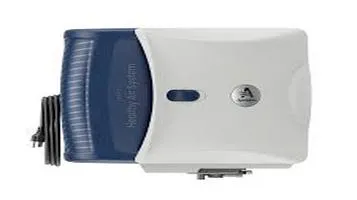Humidifiers: Enhancing Comfort and Health in Your Home
Humidifiers are devices designed to increase moisture levels in the air, enhancing indoor comfort and air quality. They are particularly beneficial during colder months when heating systems can dry out the air, leading to discomfort and health issues such as dry skin, irritated sinuses, and respiratory problems. By maintaining optimal humidity levels, typically between 30% and 50%, humidifiers help alleviate symptoms of colds and allergies, protect wooden furniture, and prevent static electricity. Available in various types, including evaporative, ultrasonic, and steam vaporizers, each uses different technologies to disperse mist into the air. Humidifiers are essential for creating a healthier home environment, particularly in arid climates or during winter, improving overall well-being and comfort for occupants.

As the seasons change, particularly during the colder months, many people find themselves dealing with dry air in their homes. This can lead to a host of issues, including dry skin, irritated sinuses, and even exacerbated respiratory problems. Humidifiers have become an essential household appliance to combat these issues, providing a more comfortable living environment. In this review, we will explore the various types of humidifiers, their benefits, potential drawbacks, and key considerations when purchasing one.
Types of Humidifiers
Humidifiers come in different types, each with its own method of adding moisture to the air:
1. Evaporative Humidifiers: These are among the most common and straightforward. They work by drawing air through a wet wick or filter. The water evaporates into the air, increasing humidity. They are usually self-regulating, as the evaporation rate decreases when the air becomes more humid.
2. Ultrasonic Humidifiers: These use ultrasonic vibrations to produce a fine mist, which is then released into the air. They are known for being very quiet, making them ideal for bedrooms or nurseries. Additionally, they often come in cool mist and warm mist options.
3. Steam Vaporizers: Also known as warm mist humidifiers, these devices heat water to create steam, which is then cooled slightly before being expelled into the air. They can help reduce bacteria and allergens, but they do use more electricity and can be a burn risk if not handled properly.
4. Impeller Humidifiers: These use a rotating disk to fling water at a diffuser, breaking the water into fine droplets that are expelled into the air. They are generally quieter than evaporative humidifiers and are typically less expensive.
Benefits of Humidifiers
1. Relief from Respiratory Issues: Dry air can irritate the respiratory tract, leading to symptoms such as coughing, sore throats, and congestion. Humidifiers add moisture to the air, which can help soothe these symptoms.
2. Skin and Hair Health: Dry indoor air can lead to dry skin, chapped lips, and brittle hair. By maintaining optimal humidity levels, humidifiers can help keep your skin hydrated and your hair healthy.
3. Protection for Wooden Furniture and Musical Instruments: Wood can crack and warp when exposed to dry air for prolonged periods. Humidifiers help maintain the integrity of wooden furniture, floors, and musical instruments by preventing them from drying out.
4. Improved Sleep: Adequate humidity levels can improve sleep quality by preventing dry nasal passages and throats, reducing snoring, and providing a more comfortable sleeping environment overall.
Potential Drawbacks
While humidifiers offer numerous benefits, there are some potential drawbacks to be aware of:
1. Maintenance: Humidifiers require regular cleaning to prevent the growth of mold, bacteria, and mildew. Failure to maintain them properly can lead to the dispersal of these harmful microorganisms into the air.
2. Over-Humidification: Excessive humidity can create a breeding ground for dust mites and mold, which can exacerbate allergies and asthma. It is essential to monitor humidity levels and keep them within the recommended range of 30-50%.
3. Noise: Although many modern humidifiers are designed to operate quietly, some models can still produce a noticeable noise, which might be disruptive, especially in quiet environments like bedrooms.
Key Considerations When Purchasing a Humidifier
When selecting a humidifier, consider the following factors:
1. Room Size: Humidifiers are rated for different room sizes. A small humidifier may be suitable for a bedroom, but larger living spaces will require a unit with a higher output.
2. Noise Level: If noise is a concern, particularly for bedrooms or nurseries, opt for an ultrasonic humidifier, as they are generally the quietest.
3. Ease of Cleaning: Look for models with removable parts and wide openings that make cleaning easier. Regular maintenance is crucial for preventing microbial growth.
4. Humidistat: A built-in humidistat can automatically regulate the device to maintain the desired humidity level, preventing over-humidification.
5. Filter Requirements: Some humidifiers use filters that need to be replaced periodically. Consider the cost and availability of replacement filters when making your decision.
6. Additional Features: Some humidifiers come with additional features such as timers, multiple mist settings, and aromatherapy diffusers. While these can enhance usability, they may also increase the price.
Conclusion
Humidifiers are invaluable tools for improving indoor air quality and overall comfort, especially during dry seasons. By understanding the different types of humidifiers and their respective benefits and drawbacks, you can make an informed decision that best suits your needs. Regular maintenance and mindful use are key to maximizing the benefits of your humidifier while minimizing potential downsides. Whether for health reasons, comfort, or the preservation of your home’s interior, a good humidifier can make a significant difference in your daily living environment.






